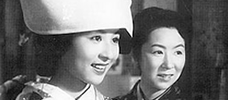Reviews
Nagareru
Mikio Naruse
Japan, 1956
Credits
Review by Ian Johnston
Posted on 28 November 2007
Source Eureka!/Masters of Cinema DVD
Categories Flowing: The Films of Mikio Naruse
The final minutes of Flowing offer a quintessential Naruse conclusion. The setting is a traditional geisha house (in actual fact an okiya, a kind of brokerage house which connects geisha up with clients, whom they meet elsewhere) which is undergoing a slow process of decline and disintegration, as the owner Madam Tsutayako finds it increasingly difficult to keep the house running and to make ends meet. In this concluding sequence Tsutayako and another middle-aged geisha Someko perform on the shamisen as six-year-old Fujiko (daughter of Tsutayako’s niece Yoneko and with whom Tsutayako has begun the long period of geisha training) goes through a series of formal dance moves. This scene is an affirmation of the traditional values represented by geisha culture but there’s sadness and poignancy here as well.
We already know more of what the future has in store for the Tsuta House than Tsutayako herself. But Naruse doesn’t develop any further this part of the story, the plans being concocted by Tsutayako’s supposed mentor and helper Mrs. Mizuno, which we learn about through the Tsuta House maid Oharu and which Oharu keeps silent about it. Instead, Naruse in effect “freezes” the narrative with this final sequence of the film and leaves us with this performance of traditional geisha culture. It’s a valiant but hopeless (more hopeless than the performers realise) resistance to the inevitable flow of time and to the flow of social and cultural changes. To underline this, there’s a flow here between the scenes of the performance downstairs and those upstairs where Katsuyo, Tsutayako’s daughter, is working on a sewing machine.
Katsuyo has decided not to follow her mother in the geisha profession and the sewing machine is her way of trying to secure an income on her own terms. The whirr of the sewing machine merges in with the sound of the music performance, providing a constant reminder of the changes at work and the precariousness of Tsutayako’s position. That change will come is the point of the final shots of the flowing river (a reprise of Flowing’s opening shots) but the precise details of what the future has in store are, as almost always with Naruse, left deliberately unclarified—just as much as with Repast’s husband and wife, Late Chrysanthemums’ geishas, Kikuko in The Sound of the Mountain, Keiko in When A Woman Ascends the Stairs, and most famously in the close-up on Reiko in Yearning.
The geisha house setting of Flowing inevitably raises comparisons with those Mizoguchi films that deal with this subject matter. In Mizoguchi’s case, the figure of the geisha or prostitute (and there is a distinction) becomes a rallying point for a critique of the suffering imposed on women by a male-ordered society, a critique that burns white-hot with anger in his two magnificent films from 1936, Osaka Elegy and Sisters of the Gion. (And note that those films’ tremendous star Isuzu Yamada is the actress Naruse chose twenty years later to play Tsutayako here in Flowing—not that we should read any allusive significance on Naruse’s part in his choice of actress.) Later Mizoguchi films dealing with geisha (Gion Water Music, The Woman of Rumour) or prostitution (Street of Shame) lose the anger in place of a distanced mournfulness which can push close to an indulgence in these women characters’ masochistic suffering.
Naruse’s tone is very different from Mizoguchi’s. With Mizoguchi you get the sense, for all his feeling for and empathy with his female characters, that this is the vision of a male director looking in from the outside, and I think that this is an impression reinforced through his style: the long takes with moving camera, the staggered planes of action he creates through his utilisation of the layout of the traditional Japanese house. In Flowing Naruse, in great contrast, refuses to assert an authorial hand; the overt presence of the male director’s eye is withdrawn from the film as much as that of the male characters in general.
For this is the great distinction of Flowing. Male characters, and in particular the geisha’s male clients, have absolutely no role, and the latter make no appearance in the film. Even our entry into the world of the geisha comes through a female character. She is Rika, a widow fallen on hard times who takes on the job of maid in the geisha house. There is surely a hint of the harsher realities of the geisha life here, the interchangeability of the women and their fundamental function as tradable commodities, in the way Rika’s name is casually, for the sake of easier pronunciation, changed to “Oharu”. You can easily come across reviews that point to the fact that this Oharu is played by Kinuyo Tanaka, Mizoguchi’s Oharu, and how this must be a referencing on Naruse’s part, but it’s an assumption I’d be very wary of making—especially as the characters and story of Flowing all come from a novel by Aya Koda, who wrote it based on her own experiences in a role similar to that of Rika/Oharu.
The geisha house of Flowing is, then, a house of women, one where no one woman’s story (or one great actress playing her) predominates. At the centre is the proud figure of Madam Tsutayako, hopelessly in debt to her own sister, victimised in her past relationships (abandoned by her husband and recently embezzled {“bankrupted”, perhaps? Can individuals be embezzled?} by a lover) and - it is implied - soon to be exploited and betrayed by her supposed mentor Mrs. Mizuno. (There is an indication that Mrs. Mizuno is working in league with Seki, the male assistant to Tsutayako’s former patron: this would be on Mrs. Mizuno’s part the ultimate betrayal, in a film that privileges the relationships between women and positions males on the outside.)
However hopeless the case may be, in spite of the constant economic pressure on the precarious situation of her house, Tsutayako remains committed to the culture of the geisha world. Traditional performances open and close the film, and Oharu’s refusal to betray Tsutayako by accepting Mrs. Mizuno’s offer is an endorsement of Tsutayako’s integrity and commitment, and an acknowledgement, too, of the value of Tsutayako’s constant attempts to find a way out of her financial impasse, of her struggles and her refusal to knuckle under and give up.
But the story of Flowing is not restricted to that of Tsutayako. There are also the other geisha in the Tsuta house. In one of the film’s early scenes there’s the young geisha Namie who accuses Tsutayako of cheating her, which gives an added, more complex layering to Tsutayako’s character, especially as that accusation is repeated by another character on another occasion. Namie soon leaves the scene (the repeated visits of her boorish uncle demanding compensation are an important subplot to the film) but two other geisha are characters that are given significant space in the film.
These two characters bring a lighter, even comic tone to the film, most prominently when on one occasion they return drunk from an assignation and prance around the room singing and dancing. First, there’s Someko, an older, middle-aged geisha, a lively woman with a taste for gossip and snacks. It’s important that in spite of her very different personality and her run-in with the mistress of the house over being underpaid, in the end she joins Tsutayako in the traditional shamisen performance in the film’s final sequence. Regardless of her essentially comic role in the film, she is as seriously committed to this geisha culture as Tsutayako herself.
The other main geisha character is the much younger Nanako. She seems much less tied to the traditions of the geisha world—frequently dressed in Western clothes, she’s the spunky, vivacious representative of contemporary post-War Japanese woman. Yet we shouldn’t forget she’s also the kind of geisha despised by Mrs. Mizuno, a sign of the decline of geisha standards and (for Mrs. Mizuno) of the Tsuta house itself.
Rounding off this house of women are two characters whose lives are exterior to the world of the geisha. I’ve already mentioned how the maid Rika/Oharu acts as our guide into the house’s geisha life and into the story of the film. Her admiration for and dedication to Tsutayako, the practical support she gives in her day-to-day work, and her demonstration of loyalty at the end of the film all affirm the moral value of Tsutayako’s ultimately doomed attempts to preserve her house.
Tsutayako’s own daughter Katsuyo offers a very different external perspective on her mother’s world. Although she’s played by Hideko Takamine, Naruse’s favourite actress of the fifties and sixties, it’s a much less sympathetic role than usual. In Flowing she stands out less than usual due to the choral nature of the film’s performances, the way her character is merely one strand in a tapestry of many. Also, her character here is a rather sour and embittered one. She is someone who has abandoned a geisha career and who is with some desperation looking around for alternative ways of making a living (although there’s little sign she’s finding any success) in order to be able to offer some means of supporting her mother.
There’s no indication at the end that Katsuyo’s operating a sewing machine offers any more of an escape from her mother’s financial and career impasse. The flow of sound and image between downstairs and upstairs, between geisha work/performance and non-geisha simply continues the narrative structure of the film as a whole, the way the separate strands of story flow from one into the other and back again. When, in Flowing’s last few seconds, the film returns to the river that it opened with, the ironic poignancy and implicit tragedy of this final sequence in the House of Tsuta ends up being subsumed in the onward flow of life.
More Flowing: The Films of Mikio Naruse
-

Wife! Be Like a Rose!
1935 -

Mother
1952 -

Older Brother, Younger Sister
1953 -

The Sound of the Mountain
1954 -

Floating Clouds
1955 -

Flowing
1956 -

Summer Clouds
1958 -

Yearning
1964 -

When a Woman Ascends the Stairs
1960 -

Repast
1951
We don’t do comments anymore, but you may contact us here or find us on Twitter or Facebook.



